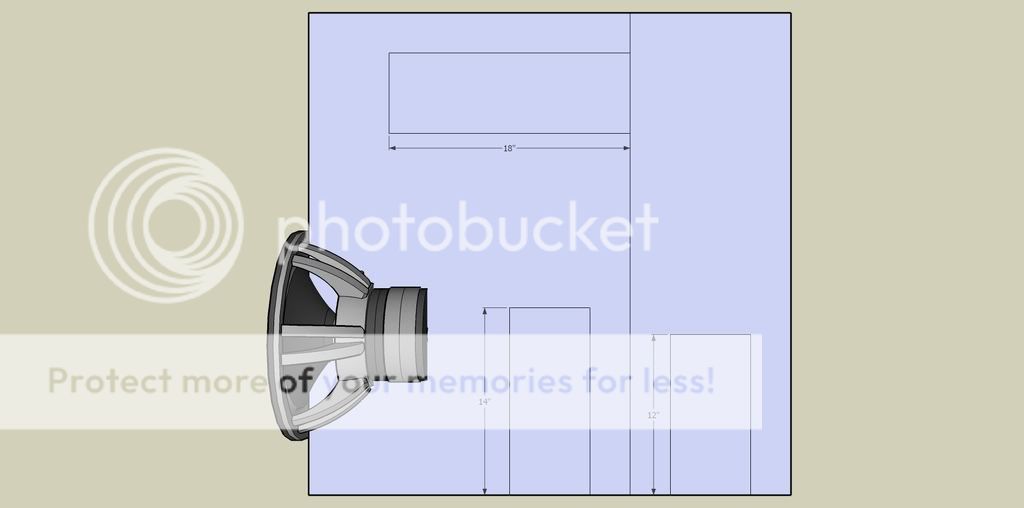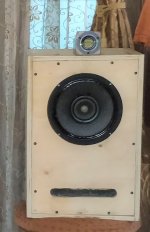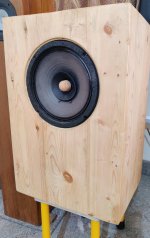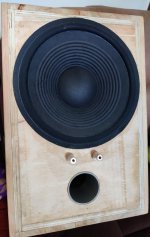Hi guys
I am contemplating building a subs using both ports and a passive radiator. The box will be big (circa 480 liter nett.) and my idea is to use dual length ports tuned to both 25Hz and 20Hz. But, since the sub will be capable of it, I want to add a PR, tuned low, for extension below 20Hz. Ports of any decent size for frequencies below 20Hz gets very long. My thinking is that with the ports in the box the PR will be lossy, which is OK, but there will be some additional extension. I might also experiment putting some wool in the ports to see what the effect will be on the PR. My question is just- will it work? My thinking is that this will be like multi-length ports, albeit more lossy in the very low frequencies than ports would be. Any thoughts?
Deon
I am contemplating building a subs using both ports and a passive radiator. The box will be big (circa 480 liter nett.) and my idea is to use dual length ports tuned to both 25Hz and 20Hz. But, since the sub will be capable of it, I want to add a PR, tuned low, for extension below 20Hz. Ports of any decent size for frequencies below 20Hz gets very long. My thinking is that with the ports in the box the PR will be lossy, which is OK, but there will be some additional extension. I might also experiment putting some wool in the ports to see what the effect will be on the PR. My question is just- will it work? My thinking is that this will be like multi-length ports, albeit more lossy in the very low frequencies than ports would be. Any thoughts?
Deon
I am glad you posted this questioni
Hi I have been building speakers over twenty years now and I have some insight here. There are a few hurdles here. In some ways a passive radiator does some of what a tuned port does. You would target a frequency and gain spl in that target range. There are those who shun passive radiators as boomy but done right they can be effective.The radiator is tunning a narrow frequency range to a greater effeciency, and the added port (which also does this)making a passive radiator calculation a lot more complicated. It is not like just calculating a dual port bass reflex. I am not saying it can't be done,but it mat become a difficult balance to figure the calculations. I have not checked but I want to say polk did this with the new lsi M series.You might want to look at one of thier cut away illustrations. Port turbulance can be an issue in a normal set up, and they use anti chuffing ports that help to prevent port noises. I don't want to sound too negative here because I have not tried building one. I don't normaly comment on what I have not built,but I can imagine a battle getting the right radiator size and cone compliance selection as opposed to the ports tunning demands. If memory serves me correct and Polk did this than there must have been a benefit or why would they go through the effort of putting it together? I just can't remenber running across any calculation tables for for what you are interseted in. The Polks are not using true sub chambers either. The aperiodic loading of the tubes(you are already doing) can in of itself cut port noise but it can can greatly contribute to killing a woofer if the calcs are off.
Hi I have been building speakers over twenty years now and I have some insight here. There are a few hurdles here. In some ways a passive radiator does some of what a tuned port does. You would target a frequency and gain spl in that target range. There are those who shun passive radiators as boomy but done right they can be effective.The radiator is tunning a narrow frequency range to a greater effeciency, and the added port (which also does this)making a passive radiator calculation a lot more complicated. It is not like just calculating a dual port bass reflex. I am not saying it can't be done,but it mat become a difficult balance to figure the calculations. I have not checked but I want to say polk did this with the new lsi M series.You might want to look at one of thier cut away illustrations. Port turbulance can be an issue in a normal set up, and they use anti chuffing ports that help to prevent port noises. I don't want to sound too negative here because I have not tried building one. I don't normaly comment on what I have not built,but I can imagine a battle getting the right radiator size and cone compliance selection as opposed to the ports tunning demands. If memory serves me correct and Polk did this than there must have been a benefit or why would they go through the effort of putting it together? I just can't remenber running across any calculation tables for for what you are interseted in. The Polks are not using true sub chambers either. The aperiodic loading of the tubes(you are already doing) can in of itself cut port noise but it can can greatly contribute to killing a woofer if the calcs are off.
Last edited:
OK, here is my main idea. I want too build a pair of giant subs. As I said, the total box size will be circa 480-liters nett. The drivers that I will be using are the old Leak Sandwich 13" bass drivers and, as you may well know, they do not have any TSPs available so I will have to make a plan to measure those before I do this. I will probably buy Dayton's full measuring suite to do this. This will also help me with the setup afterwards. I already have a pair of ceramic units and a pair of alnico units and will be buying the rest in the coming months. I will be using 4 drivers per box- two ceramic and two alnico. I will also be actively quad-amping. Being quad-amped I can then more easily correct for in-room response variations, which will provide a lot of flexibility.
The Leak drivers have a very low Fs (circa 19Hz AFAIK), but they also have a low Qt. That is why I was thinking of reflex rather than the sealed they were used in. Like said, my current idea is to do dual length porting (OK, multi-length if we add in the effect of the PR), with ports at 25Hz and 20Hz. There will be 10 ports in total. Six of the ports will be tuned to 20Hz, four of them tuned to 25Hz. If you look at the pic below, the bottom, middle and top pairs of ports will be tuned to 20Hz. The other two inbetween pairs will be tuned to 25Hz. The PR will be tuned low, I estimate circa 10Hz - 15Hz, but closer to 10Hz. There will also be a shelf in the box between the lowest driver and the PR. The shelf will extend near half the depth of the box. This is to more evenly load the all the drivers to the PR. Here is a basic drawing of my idea for the box:
I was thinking of building my own PR from loose drivers parts. All the parts are available from a vendor on eBay to build your own 21" bass driver- from the basket to the cone, various spiders, magnets (up to 400oz. monsters!) and different VCs on differing sized VC formers. The seller's name is ultra_audio_1. I will only be using the basket, cone, dust cap and spiders. I will substitute a 4" PVC pipe for the VC former as I will not need a VC. I can then add material like rope caulk in to this pipe to mass-load the PR down to the required Fs. I was also thinking of using four spiders per PR- two on each side of the VC gap on the frame. I don't have a magnet on the back, so I can add one pair of spiders there and the other pair in the normal place. This should make for a very tight low-bass response as well as keep the PR running linear. I know a single 21" PR is too small for the four Leak 13" drivers, but in this case it will have to do. It will only be doing very low bass, and there is not that much of that in most music, so I think it ought to be OK (or rather I hope so). Comments on this aspect will also be appreciated. Here are the links for the various pieces I will be using:
21" Subwoofer Cone Fat Roll CN2130 | eBay
21" Basket Frame Subwoofer | eBay
7" 177 8mm Poly Dome Dust Cap Speaker Subwoofer Woofer | eBay
10" x 4" Subwoofer Spider Damper XHDZ046 1 | eBay
This is the name of the store:
ultra_audio_1 | eBay
OK, after all this is said and done, this design depends a lot on the TSPs I get when I measure the Leak drivers. If I find that they are not really suited to a large reflex, I will change my design at that time. For the moment I am just putting this out there to get ideas and comments.
Any suggestions or comments (even if only to say I am crazy) would be appreciated.
Thanks,
Deon
PS. The upright design is due to the available space I have for them. If I could, I would have made it a more square design with the drivers in two pairs, side-by-side. I would then have used two 18" PRs below them, but as it stands, the single 21" is the biggest unit I can fit into the existing design.
The Leak drivers have a very low Fs (circa 19Hz AFAIK), but they also have a low Qt. That is why I was thinking of reflex rather than the sealed they were used in. Like said, my current idea is to do dual length porting (OK, multi-length if we add in the effect of the PR), with ports at 25Hz and 20Hz. There will be 10 ports in total. Six of the ports will be tuned to 20Hz, four of them tuned to 25Hz. If you look at the pic below, the bottom, middle and top pairs of ports will be tuned to 20Hz. The other two inbetween pairs will be tuned to 25Hz. The PR will be tuned low, I estimate circa 10Hz - 15Hz, but closer to 10Hz. There will also be a shelf in the box between the lowest driver and the PR. The shelf will extend near half the depth of the box. This is to more evenly load the all the drivers to the PR. Here is a basic drawing of my idea for the box:
An externally hosted image should be here but it was not working when we last tested it.
I was thinking of building my own PR from loose drivers parts. All the parts are available from a vendor on eBay to build your own 21" bass driver- from the basket to the cone, various spiders, magnets (up to 400oz. monsters!) and different VCs on differing sized VC formers. The seller's name is ultra_audio_1. I will only be using the basket, cone, dust cap and spiders. I will substitute a 4" PVC pipe for the VC former as I will not need a VC. I can then add material like rope caulk in to this pipe to mass-load the PR down to the required Fs. I was also thinking of using four spiders per PR- two on each side of the VC gap on the frame. I don't have a magnet on the back, so I can add one pair of spiders there and the other pair in the normal place. This should make for a very tight low-bass response as well as keep the PR running linear. I know a single 21" PR is too small for the four Leak 13" drivers, but in this case it will have to do. It will only be doing very low bass, and there is not that much of that in most music, so I think it ought to be OK (or rather I hope so). Comments on this aspect will also be appreciated. Here are the links for the various pieces I will be using:
21" Subwoofer Cone Fat Roll CN2130 | eBay
21" Basket Frame Subwoofer | eBay
7" 177 8mm Poly Dome Dust Cap Speaker Subwoofer Woofer | eBay
10" x 4" Subwoofer Spider Damper XHDZ046 1 | eBay
This is the name of the store:
ultra_audio_1 | eBay
An externally hosted image should be here but it was not working when we last tested it.
OK, after all this is said and done, this design depends a lot on the TSPs I get when I measure the Leak drivers. If I find that they are not really suited to a large reflex, I will change my design at that time. For the moment I am just putting this out there to get ideas and comments.
Any suggestions or comments (even if only to say I am crazy) would be appreciated.
Thanks,
Deon
PS. The upright design is due to the available space I have for them. If I could, I would have made it a more square design with the drivers in two pairs, side-by-side. I would then have used two 18" PRs below them, but as it stands, the single 21" is the biggest unit I can fit into the existing design.
Last edited:
Deon,There will be 10 ports in total. Six of the ports will be tuned to 20Hz, four of them tuned to 25Hz. If you look at the pic below, the bottom, middle and top pairs of ports will be tuned to 20Hz. The other two inbetween pairs will be tuned to 25Hz. The PR will be tuned low, I estimate circa 10Hz - 15Hz, but closer to 10Hz.
Any suggestions or comments (even if only to say I am crazy) would be appreciated.
No comment on your mental health, but multiple ports result in an aggregate, not individual "tunings", and adding a passive radiator will also contribute to the single aggregate tuning. The "Q" of the aggregate tuning may be a bit wider than "normal", but ultimately there will still only be one Fb, though the difference in the port length and the way the PR react may result in an Fb that changes with excursion, Fb rising as excursion increases.
To limit excursion below a variable Fb, the HP filter would need to be dynamically variable .
PPS. The reason I posted the URL for the eBay store as a pic is because whenever I add the actual link, the URL get's changed to a totally useless URL that leads to a page that does not exist. I don't know if this is the eBay-police doing this, but it is highly annoying.
Use https://bitly.com/ to shorten the URL.
You are going to great lengths to build something that is a fraction of performance available with "conventional" technology.
Hi,
The low tuned PR won't do anything due to the other ports
depressurising the cabinet below their tuning. With 25Hz and
20Hz tuning the 25Hz will have a little more effect than 20Hz,
it adds a little damping, but is pretty pointless compared to
straight 22/23Hz tuning, in the general scheme of things.
rgds, sreten.
FWIW your just guessing, and spending money on
drivers that though decent in their day would get
slaughtered by modern drivers at low frequencies,
especially in terms of power handling and excursion.
2 LAB12's in a 240L box tuned to 16Hz to 20Hz
with say 600W would eat the above for breakfast.
The low tuned PR won't do anything due to the other ports
depressurising the cabinet below their tuning. With 25Hz and
20Hz tuning the 25Hz will have a little more effect than 20Hz,
it adds a little damping, but is pretty pointless compared to
straight 22/23Hz tuning, in the general scheme of things.
rgds, sreten.
FWIW your just guessing, and spending money on
drivers that though decent in their day would get
slaughtered by modern drivers at low frequencies,
especially in terms of power handling and excursion.
2 LAB12's in a 240L box tuned to 16Hz to 20Hz
with say 600W would eat the above for breakfast.
Last edited:
I admire the tenacity
There is a route you might consider but its some extra carpentry work. A straight forward tactic (I have used many times) is building inexpensive prototype enclosures. First I build a conventional enclosure for the drivers and test it. Spl tests, mic tests, crossover,and music in the listening area. Then I charge forward building that second from the blue print enclosure for a more exotic design,tweak and learn. I see if I am gaining anything over a standard design. This requires care and can result in the ambitious build torturing a driver, but you can discover much. This is one reason I use adjustable electronic crossovers and a test amp,or amps. I must agree with the other forum members however that achieving multiple tunning points out of one box would be quite a trick. I was looking at it as attempting a broader freq tunning effect. In building prototypes you might discover a speaker does not live up to expected bp. You might learn you love the speaker only using a passive radiator with the woofer when compared to any kind of porting set up?
There is a route you might consider but its some extra carpentry work. A straight forward tactic (I have used many times) is building inexpensive prototype enclosures. First I build a conventional enclosure for the drivers and test it. Spl tests, mic tests, crossover,and music in the listening area. Then I charge forward building that second from the blue print enclosure for a more exotic design,tweak and learn. I see if I am gaining anything over a standard design. This requires care and can result in the ambitious build torturing a driver, but you can discover much. This is one reason I use adjustable electronic crossovers and a test amp,or amps. I must agree with the other forum members however that achieving multiple tunning points out of one box would be quite a trick. I was looking at it as attempting a broader freq tunning effect. In building prototypes you might discover a speaker does not live up to expected bp. You might learn you love the speaker only using a passive radiator with the woofer when compared to any kind of porting set up?
Right it will not work.
A passive is just another form of port, with some advantages (higher mass than air trapped in a tube, not port noise).
The tuning freq will shift, and you will not have 2 tuning frequencies.
Play with this sim model (LTspice)... really good for looking at this ... just add another port in parallel, and look at the summed out put .. 2 x port + driver.
Baldin
A passive is just another form of port, with some advantages (higher mass than air trapped in a tube, not port noise).
The tuning freq will shift, and you will not have 2 tuning frequencies.
Play with this sim model (LTspice)... really good for looking at this ... just add another port in parallel, and look at the summed out put .. 2 x port + driver.
Baldin
Attachments
A pair of Altec 409-16 T have been with me for about 2 years now. Having read a lot on the web and our forum on the limitations as this is a PA Celing speaker I could not do much other than putting it into a box based on some Japanese designs where these seem seem to be pretty popular.
Results were OK but lacked even a moderate bottom end response.
Later I experimented by closing the front slot port and instead going for a 12 inch passive radiator in the back. Results were good but even then there was a gap in the frequency response.
Now have modified the original speaker, removing the tweeter and inserted a whizzer cone + phase plug. Post testing have also added a port with some damping. Results are very satisfying - i dont even need a super tweeter now and the lows are adequate. Playing through my 3 watt tube amp.
Results were OK but lacked even a moderate bottom end response.
Later I experimented by closing the front slot port and instead going for a 12 inch passive radiator in the back. Results were good but even then there was a gap in the frequency response.
Now have modified the original speaker, removing the tweeter and inserted a whizzer cone + phase plug. Post testing have also added a port with some damping. Results are very satisfying - i dont even need a super tweeter now and the lows are adequate. Playing through my 3 watt tube amp.
Attachments
- Status
- This old topic is closed. If you want to reopen this topic, contact a moderator using the "Report Post" button.
- Home
- Loudspeakers
- Subwoofers
- Passive radiator + ports - possible?



